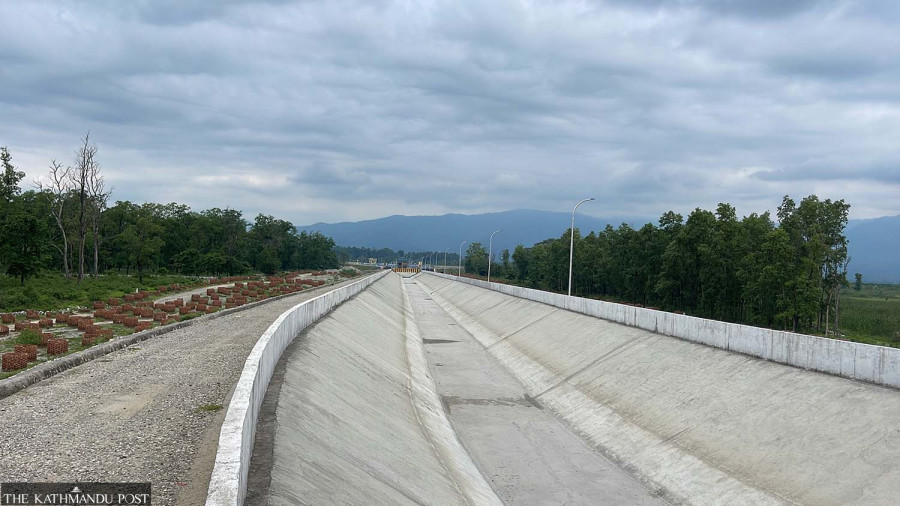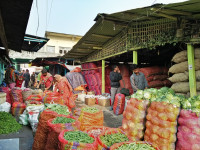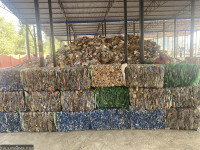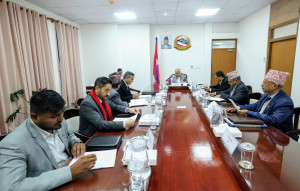Money
It’s Mahakali irrigation phase III and the canal runs dry
Nearly two decades into development, the project has built major canal infrastructure across far-western Nepal.
Bhawani Bhatta
It’s nearly two decades since work began on the third phase of the Mahakali Irrigation Project.
A 28-kilometre central canal from Brahmadev to Phaleli in Shuklaphanta Municipality has been completed. An additional 20 kilometres of canal, stretching from Phaleli to Godawari in Kailali, is still under construction.
Half of the 22 branch canals planned along the 28 kilometres of the completed main canal have already been built, while the other half are underway.
If water were to be released from the Tanakpur barrage, farmers could irrigate their fields through at least half of these branches. However, despite the completion and even testing of the canal, water has yet to flow—largely due to hesitation on the Indian side.
“If water reaches the canal, it can be delivered to the fields,” said Yogendra Mishra, director of the Mahakali Irrigation Project Phase III. “Some older irrigation systems have been repaired, and new branches have already been constructed.”
According to him, the completed branches could irrigate around 3,000 hectares of farmland. Once all 22 branches are finished, irrigation will be possible on up to 5,000 hectares.
The project has repeatedly contacted India’s National Hydropower Corporation (NHPC) to secure water from the Tanakpur barrage.
However, NHPC insists that water can only be released after receiving orders from higher authorities in Delhi.
The project office has already informed the department in Kathmandu about this. Two years ago, the canal saw a trial operation, and water from the system was successfully used for paddy plantation in Ward 4 of Bedkot Municipality in Baitadi. Since then, however, no water has flowed through the canal.
In December 2021, a plan was to inaugurate the project during then-Prime Minister Sher Bahadur Deuba’s visit to India. Deuba and Indian Prime Minister Narendra Modi were scheduled to jointly inaugurate it online. But the visit was postponed due to a Covid outbreak, and the inauguration never happened.
Later, in 2022, the project was again prepared for inauguration during then-prime minister Pushpa Kamal Dahal’s visit to India. Reports were submitted accordingly through the department.
However, NHPC officials inspected the site and claimed the infrastructure was not ready, leading to a cancellation.
Mishra said that if water were to start flowing, it would also put pressure on contractors to speed up work.
With all 22 branches complete, the project can deliver water directly to farmlands. However, some disputes over compensation remain in various sections. The hope is that once water starts flowing, minor disputes will resolve themselves.
There was also a prolonged disagreement over the water level at which India would release water.
According to the project officials, India initially wanted to release water from the 245-metre level, while Nepal demanded it be released from a lower level. Eventually, after lengthy discussions, India agreed to release water at the 242.5-metre level.
There have been delays in the project due to budget shortfalls, land compensation disputes, and slow construction.
In the project’s first ten years, only 12 kilometres of canal were completed.
In 2020, the project was upgraded to a National Pride Project, which increased funding and accelerated progress. In the current fiscal year, the project received a budget of around Rs2 billion, of which Rs520 million was allocated for land compensation and Rs1.41 billion for construction.
Director Mishra said that compensation payments have again been delayed due to disputes over official land valuations and mismatches between land ownership documents and actual land users.
For example, in Ward 1 of Krishnapur Municipality, locals have agreed to the valuation, which ranges from Rs585,000 to Rs1.185 million per kattha. In contrast, in ward 4 of the same municipality, acquiring 45 plots has been difficult because land is officially owned by one person but cultivated by another.
There have also been delays due to the late approval for tree felling in forest areas. Logging permits for both community and national forests were only granted in April after being held up for a year and a half.
According to Mishra, 9,000 trees are currently being felled in the concerned areas.
Construction on the 20 kilometres of the remaining canal continues under four different packages. Despite delays due to logging and compensation issues, the goal is to complete the main canal by the next fiscal year.
Following that, the project plans to begin building additional branch canals. Under this expansion, 45 kilometres of branch canals will be built from Phaleli to the end of the resettlement area.
Additionally, a branch canal will be built in the Gulariya area of Krishnapur.
In total, there will be 31 branches. So far, Rs9 billion has been spent on the project, with Rs1.72 billion used for land compensation. Once completed, the project will provide irrigation to 33,520 hectares of farmland in Kanchanpur and Kailali.
According to the Mahakali Treaty, 1,000 cubic metres per second (cusec) of water will be available from the Tanakpur Barrage for irrigation in Phase III. Earlier, the first and second phases of the Mahakali Irrigation Project were completed, and water was received from the Sharda Barrage.
Between 1985 and 1995, canals were built up to Belauri in Kanchanpur, and they now irrigate 11,600 hectares. The Sharda Barrage supplies 350 cusec water to these systems.
Phase III also includes plans to build an irrigation canal in the Dodhara Chandani area. According to the treaty, India is responsible for supplying water from the Sharda Canal and building a 1.2-kilometre canal stretch within its territory.
“We’ve already completed the DPR and land acquisition for the canal in Dodhara Chandani,” said Mishra. “As there’s an older irrigation system in some areas, we don’t need to acquire much land.” He added that land for a kilometre of the canal has already been acquired and that the system would irrigate 3,500 hectares.
“If we can get water flowing from Brahmadev, we’ll move ahead on the Dodhara Chandani section as well,” Mishra said. “We’ve built the canal here, but there’s no water—what’s the point of having a canal on the other side too if there is also no water flowing through it?”
India has also been reluctant to provide water from the Sharda Canal for irrigation in Dodhara Chandani. Article 3 of the Mahakali Treaty calls for constructing the Pancheshwar Multipurpose Project, while Article 4 guarantees irrigation water for Dodhara Chandani.
But Indian authorities insist that Pancheshwar must be built before they release water for Dodhara Chandani, citing Article 3 as a prerequisite.
Meanwhile, cultivable land in the region is shrinking, reducing the project’s area. Although this is a growing concern, there has been no formal study on it.




 8.12°C Kathmandu
8.12°C Kathmandu















